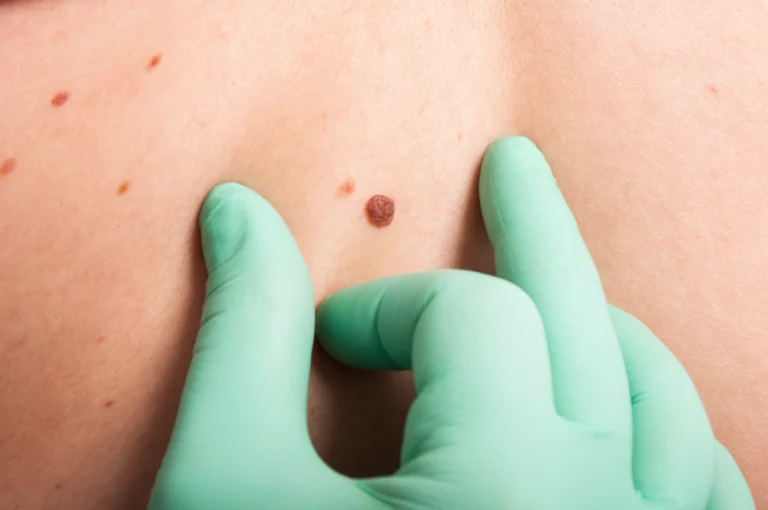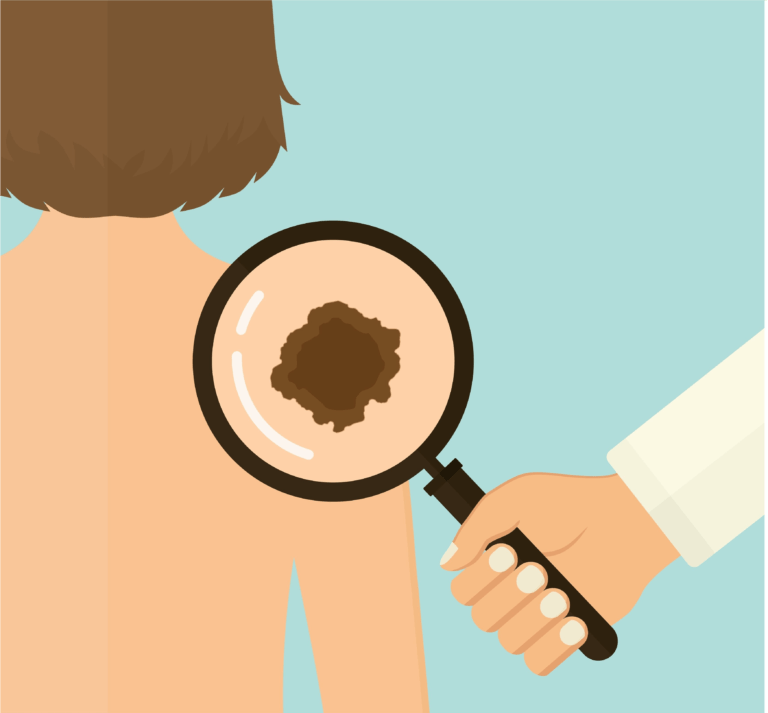Moles are commonly found on skin. Most of the time they are benign (normal) and fortunately, if they are dysplastic (abnormal) they are easily treated when identified early. Unfortunately, delays are relatively common with the long waits for dermatology appointments and delays in treatment can result in progression. Now, you can say goodbye to the overwhelming frustration and anxiety caused by months-long waiting periods for appointments. The Trillium Clinic is proudly redefining the dermatologic care model, ensuring that every patient will be seen within 14 days of requesting an appointment. Step into a new era of patient-centered care, where the agony of waiting for appointments becomes a thing of the past.
What are moles

There are several types of nevi, including:
Common Moles: These are small, round or oval-shaped moles that are usually tan, brown, or black in color. They may be flat or raised and have a smooth or slightly rough texture.
Atypical Moles: Also known as dysplastic nevi, these moles are larger than common moles and often have an irregular shape and color. They may have uneven borders and may be more prone to developing into melanoma (a type of skin cancer).
Congenital Moles: These moles are present at birth or appear shortly after. They vary in size, shape, and color and can be classified as small, medium, or large, depending on their diameter.
What causes moles

The exact cause of nevi is not fully understood, but they are generally considered to be a result of the clustering of melanocytes (pigment-producing cells) in the skin. The development of nevi can be influenced by genetic factors and exposure to sunlight.
How are moles treated
Most nevi do not require treatment unless they become bothersome or show signs of changes that may indicate skin cancer. If a nevus is suspected to be cancerous or poses a risk due to its location or size, it may be surgically excised.
Can moles be prevented
Moles cannot be prevented, but actively monitoring them is important. Regular self-examinations in combination with skin checks by a dermatologist are important to monitor any changes in nevi, particularly in atypical moles, which have a higher risk of developing into melanoma.
It’s important to note that while most nevi are benign (normal) and pose no health risks, changes in size, shape, color, or texture should be promptly evaluated by a healthcare professional. We call this the ABCDs of understanding a mole: Asymmetry, Border, Color, and Diameter (size) Irregularities in the ABCDs of a mole is what makes it concerning to a dermatologist. Additionally, individuals should protect their skin from excessive sun exposure and practice sun safety measures both to reduce the risk of developing new nevi and to prevent skin damage.
Understanding Dysplastic Nevi: What You Need to Know
Dysplastic nevi, also known as atypical moles, are unusual-looking moles that differ in appearance from common moles. They can vary in size, shape, and color and are often larger than typical moles. While most dysplastic nevi are benign (non-cancerous), they can sometimes indicate an increased risk of developing melanoma, a type of skin cancer. Understanding the different degrees of dysplasia—mild, moderate, and severe—can help you and your dermatologist determine the best course of action for monitoring and treatment.
What Are Dysplastic Nevi?
Dysplastic nevi are moles with irregular features that distinguish them from normal moles. They may have irregular borders, uneven coloration, and a more varied appearance. While the presence of dysplastic nevi is common, especially in individuals with a family history of atypical moles or melanoma, it’s important to monitor them regularly as they can be associated with an increased risk of skin cancer.
Types of Dysplastic Nevi
Mild Dysplasia
Appearance:
Moles with mild dysplasia typically show slight irregularities in shape and color. They may have uneven borders and a mixture of tan, brown, or pink hues. However, the changes are generally subtle and not as pronounced as those in more severe cases.
Risk:
Mild dysplastic nevi are generally considered low risk. They have a low likelihood of progressing to melanoma, but it’s still important to monitor them over time. Regular skin checks with your dermatologist can help ensure that any changes are detected early.
Management:
In most cases, mild dysplastic nevi do not require removal unless they exhibit noticeable changes or are located in areas prone to irritation (e.g., under clothing or in areas that are frequently shaved). Your dermatologist may recommend regular monitoring and self-examinations to keep track of any developments.
Moderate Dysplasia
Appearance:
Moles with moderate dysplasia often have more noticeable irregularities compared to mild dysplastic nevi. They may be larger, have more distinct uneven borders, and show a greater variety of colors, including darker shades of brown or black.
Risk:
Moderate dysplastic nevi carry a higher risk of developing into melanoma compared to mild dysplastic nevi. While the risk is still relatively low, it’s important to take these moles seriously and follow your dermatologist’s recommendations for monitoring or treatment.
Management:
Depending on the mole’s characteristics and your personal or family history of skin cancer, your dermatologist may recommend removal of moderate dysplastic nevi. Regular dermatological check-ups and self-monitoring are crucial to detect any changes early.
Severe Dysplasia
Appearance:
Moles with severe dysplasia are the most irregular and may appear significantly different from normal moles. They often have irregular, poorly defined borders, multiple shades of color, and may be larger than typical moles. These moles may also appear asymmetrical, with one half looking different from the other.
Risk:
Severe dysplastic nevi are associated with a higher risk of developing into melanoma. While not all severe dysplastic nevi will turn into cancer, their presence warrants careful monitoring and often more proactive treatment.
Management:
Due to the higher risk associated with severe dysplastic nevi, your dermatologist may recommend surgical removal to prevent potential progression to melanoma. Follow-up care will likely include regular skin checks and possibly additional biopsies if new atypical moles appear.
Monitoring and Prevention
Regular Skin Exams:
Whether you have mild, moderate, or severe dysplastic nevi, regular skin exams with a dermatologist are essential. Early detection of changes in these moles can significantly reduce the risk of developing melanoma.
Self-Examinations:
Perform monthly self-examinations, looking for any changes in the size, shape, color, or feel of your moles. Use the ABCDE rule—Asymmetry, Border, Color, Diameter, Evolving—to guide your examination.
Sun Protection:
Protecting your skin from UV radiation is crucial. Use broad-spectrum sunscreen with an SPF of 30 or higher, wear protective clothing, and avoid tanning beds to reduce the risk of melanoma.
When to See a Dermatologist
If you notice any changes in your dysplastic nevi, such as growth, darkening, itching, or bleeding, it’s important to see a dermatologist as soon as possible. Early intervention can prevent the development of more serious conditions.
Conclusion
Dysplastic nevi are common and often benign, but they require careful monitoring due to their potential to develop into melanoma. Understanding the differences between mild, moderate, and severe dysplasia can help you and your dermatologist make informed decisions about your skin health. Regular check-ups, sun protection, and self-awareness are key to managing these atypical moles effectively. If you have any concerns about your moles, don’t hesitate to contact your dermatologist for a thorough evaluation.
Embark on your journey
Regular skin examinations and follow-ups with a dermatologist are recommended for individuals with a history of skin cancer or multiple atypical moles to monitor for any changes or new moles. Early detection and treatment is crucial to prevent the evolution of moles. You should schedule annual skin checks if you are low risk, and more frequent total body skin examinations if you have a history of irregular moles, mole biopsies or other skin cancers.
As experts in the detection and treatment of skin cancer, we invite patients from Chapel Hill, Carrboro, Hillsborough, Pittsboro, Mebane, Durham, Burlington, Cary, and surrounding cities, to schedule their total body skin examination with us today.
You can self-schedule here or contact us by phone and we will help you find a convenient appointment. Once you arrive, a member of our dermatology team will conduct a comprehensive evaluation of your skin and discuss any findings that may be concerning. Skin cancers can be treated effectively when identified early. Do not put off your annual skin exam any longer!

